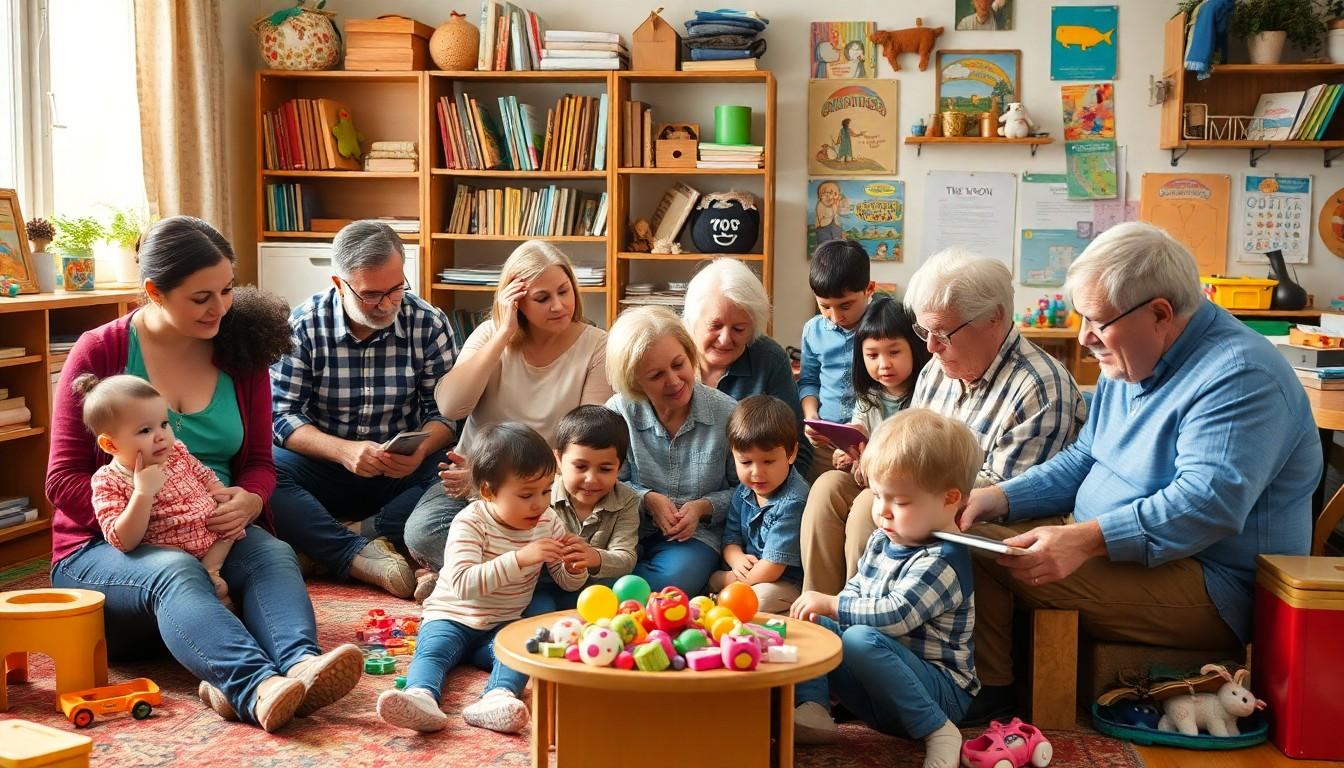Understanding human development is a complex journey, and Erik Erikson’s stages of development offer a valuable framework for navigating it. These eight stages outline the psychological challenges individuals face from infancy to old age, revealing how each phase shapes personality and social relationships.
Erikson’s theory emphasizes the importance of resolving conflicts at each stage, which ultimately influences a person’s ability to thrive in society. By exploring these stages, one can gain insights into their own growth and the development of others, making it a crucial topic for parents, educators, and mental health professionals alike.
Overview of Erikson Stages of Development
Erik Erikson’s theory comprises eight distinct stages, each marking critical conflicts that shape psychological growth. These stages span from birth to late adulthood, highlighting the interplay between personal evolution and societal expectations. Each stage presents a unique challenge, resolution of which fosters psychosocial virtues essential for healthy development.
Stage 1: Infancy – Trust vs. Mistrust
- Age: Birth to 18 months
- Conflict: The infant must form a trusting relationship with the caregiver.
- Virtue: Hope
- Maldevelopment: Mistrust, leading to anxiety and insecurity.
- Example: A secure environment, with regular access to affection and food, fosters trust.
Stage 2: Early Childhood – Autonomy vs. Shame and Doubt
- Age: 18 months to 3 years
- Conflict: The child develops a sense of personal control over physical skills and independence.
- Virtue: Will
- Maldevelopment: Shame and doubt, leading to feelings of inadequacy and low self-esteem.
Stage 3: Preschool – Initiative vs. Guilt
- Age: 3 to 6 years
- Conflict: The child explores the world, initiating activities and asserting control.
- Virtue: Purpose
- Maldevelopment: Guilt, stemming from over-criticism or control by caregivers.
Stage 4: School Age – Industry vs. Inferiority
- Age: 6 to 12 years
- Conflict: The child learns to work with others and gains skills in various domains.
- Virtue: Competence
- Maldevelopment: Inferiority, resulting from failure to succeed in social or academic activities.
Stage 5: Adolescence – Identity vs. Role Confusion
- Age: 12 to 18 years
- Conflict: The adolescent explores different identities and integrates them into a cohesive sense of self.
- Virtue: Fidelity
- Maldevelopment: Role confusion, leading to instability in personal identity.
Stage 6: Young Adulthood – Intimacy vs. Isolation
- Age: 18 to 40 years
- Conflict: The individual forms intimate relationships while balancing personal independence.
- Virtue: Love
- Maldevelopment: Isolation from failure to establish deep connections.
Stage 7: Middle Adulthood – Generativity vs. Stagnation
- Age: 40 to 65 years
- Conflict: The adult contributes to society through work and family, seeking to generate a legacy.
- Virtue: Care
- Maldevelopment: Stagnation from self-absorption or lack of growth.
- Age: 65 years and older
- Conflict: The individual reflects on life, evaluating accomplishments and failures.
- Virtue: Wisdom
- Maldevelopment: Despair results from regret over missed opportunities.
Each of these stages reinforces the importance of nurturing healthy relationships and providing support during critical conflicts. Recognizing these stages can enhance understanding of personal development and improve interactions within families and communities.
The Eight Stages Explained

Erik Erikson’s eight stages of psychosocial development outline essential conflicts that individuals encounter throughout their lives. These stages illustrate how each resolution contributes to a person’s growth and social relationships.
Trust vs. Mistrust
- Age: Birth to approximately 18 months
- Conflict: Infants rely on caregivers for stability and care. Positive experiences foster trust, while negative experiences lead to mistrust.
- Outcome: Success results in the virtue of hope, providing a sense of security.
Autonomy vs. Shame and Doubt
- Age: Approximately 18 months to 3 years
- Conflict: Toddlers focus on independence and personal control. Encouragement builds confidence, while excessive criticism cultivates shame.
- Outcome: Success leads to the virtue of will, promoting self-assurance.
Initiative vs. Guilt
- Age: Approximately 3 to 5 years
- Conflict: Young children assert control through play and initiative. Support enhances exploration, while disapproval generates guilt.
- Outcome: Success results in the virtue of purpose, fostering leadership skills.
Industry vs. Inferiority
- Age: Approximately 6 to 12 years
- Conflict: School-age children engage in cooperative activities and skill development. Recognition encourages industry, while failure may lead to feelings of inferiority.
- Outcome: Success leads to the virtue of competence, enhancing self-esteem.
Identity vs. Role Confusion
- Age: Approximately 12 to 18 years
- Conflict: Adolescents explore personal identities and roles. Successful identity formation results from healthy exploration, while confusion arises from societal pressure.
- Outcome: Success leads to the virtue of fidelity, enabling strong personal connections.
Intimacy vs. Isolation
- Age: Approximately 18 to 40 years
- Conflict: Young adults navigate intimate relationships while balancing independence. Successful partnerships foster intimacy, while fear of commitment may lead to isolation.
- Outcome: Success results in the virtue of love, facilitating deep connections.
Generativity vs. Stagnation
- Age: Approximately 40 to 65 years
- Conflict: Adults contribute to society through work or family life. Generativity involves nurturing others and creating a lasting legacy, while stagnation results from self-absorption.
- Outcome: Success leads to the virtue of care, promoting active engagement in community.
- Age: Approximately 65 years and older
- Conflict: Older adults reflect on their life experiences. A sense of fulfillment fosters integrity, whereas regret can lead to despair.
- Outcome: Success results in the virtue of wisdom, enhancing life satisfaction.
Importance of Erikson’s Theory

Erikson’s theory plays a crucial role in understanding human development throughout life. It offers a comprehensive life span approach that highlights the constant interplay between personal growth and societal demands. This framework enables individuals, parents, educators, and mental health professionals to recognize the significance of psychosocial stages in navigating life’s challenges.
Erikson’s focus on psychosocial crises in each stage sheds light on the inevitable conflicts people face. By identifying these crises, individuals better understand their experiences and the impact of relationships on personal growth. For example, the crisis of Identity vs. Role Confusion during adolescence emphasizes exploring identities to develop a cohesive self. Successfully addressing this conflict leads to a stronger sense of fidelity, essential for forming meaningful relationships in adulthood.
Additionally, the resolution of conflicts in earlier stages influences later development. For instance, individuals who establish trust during Trust vs. Mistrust may display healthier relationships in their adult lives. This interconnectedness illustrates Erikson’s assertion that each stage builds on the previous one, reinforcing the importance of addressing early conflicts.
The identification of virtues gained from resolving conflicts proves beneficial for personal development. For instance, competence gained during the Industry vs. Inferiority stage encourages individuals to pursue success in education and career paths. Understanding these virtues allows for personal reflection and growth, fostering emotional resilience and adaptability.
Moreover, Erikson’s theory aids professionals in various fields, such as psychology and education, by providing a structured framework to assess individuals’ developmental stages. It informs interventions, helping clinicians tailor support based on clients’ psychosocial needs. Understanding these stages aids educators in creating developmentally appropriate learning environments, enhancing student support.
This theory’s significance extends beyond individual experiences, impacting social relationships and community dynamics. By promoting healthy developmental practices, communities can foster environments that nurture individuals’ potential, building a more empathetic society.
Erikson’s theory emphasizes the lifelong nature of psychological development, urging people to consider their growth and relationships continuously. Recognizing the challenges across various life stages strengthens interpersonal connections, ultimately leading to a more fulfilling human experience.
Applications in Modern Psychology

Erikson’s stages of psychosocial development play a crucial role in modern psychology. His theory offers a framework for understanding personality development across the lifespan. Each stage represents a psychosocial crisis that individuals face, and resolving these crises influences future development and overall personality.
Understanding Personality Development
Erikson’s model enables psychologists to evaluate personality growth from infancy to late adulthood. The eight stages encompass essential conflicts that shape identity and social effectiveness. For instance, the Identity vs. Role Confusion stage during adolescence is critical, as individuals explore their personal identities. Successful resolution leads to a strong sense of self, while failure may contribute to insecurity and confusion.
Clinical and Therapeutic Applications
In clinical settings, therapists utilize Erikson’s stages to diagnose and treat psychological issues. Identifying which stage a client struggles with allows for tailored therapeutic approaches. For example, a young adult experiencing difficulties in forming intimate relationships may need support with the Intimacy vs. Isolation conflict. Recognizing the underlying psychosocial crisis helps therapists provide targeted interventions.
Educational Insights
Educators benefit from Erikson’s theory by understanding students’ emotional and social development. Each stage highlights different needs and competencies. For example, during the Industry vs. Inferiority stage, school-age children develop a sense of competence through academic and social interactions. Recognizing these developmental needs allows educators to foster supportive learning environments.
Longitudinal Studies and Intervention Programs
Research based on Erikson’s stages informs longitudinal studies that track development over time. These studies demonstrate the long-term impacts of successfully navigating each stage. Intervention programs often incorporate Erikson’s principles to promote resilience and healthy psychosocial development. Programs focusing on adolescents, for example, can help facilitate identity exploration and strengthen social connections.
Cultural Competence
Erikson’s theory also enhances cultural competence in psychology. Understanding the universality of his stages encourages practitioners to consider cultural influences on development. Addressing cultural factors in treatment leads to more effective therapeutic outcomes and supports personalized care.
Overall, Erikson’s psychosocial development stages are integral in modern psychological practices. They help professionals assess individual needs, offer tailored interventions, and foster personal and social growth. The enduring relevance of his theory emphasizes its value in understanding and supporting human development through a comprehensive, psychosocial lens.
Conclusion
Erikson’s stages of development provide a vital framework for understanding the complexities of human growth. Each stage presents unique challenges that shape psychological health and social relationships. By recognizing the importance of resolving these conflicts individuals can foster personal growth and cultivate meaningful connections.
This theory not only aids parents and educators in supporting developmental needs but also serves as a valuable tool for mental health professionals in addressing psychological issues. Embracing Erikson’s insights encourages ongoing reflection and understanding of one’s own development throughout life. Ultimately it highlights the interconnectedness of personal evolution and societal influences, reinforcing the significance of nurturing healthy relationships at every stage.
